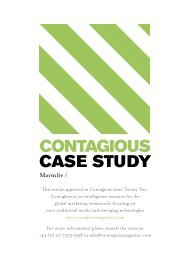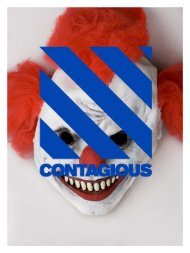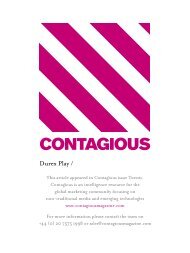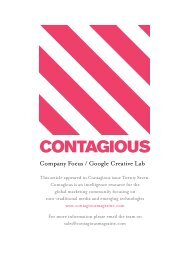CASE STUDY Uniqlo - Contagious Magazine
CASE STUDY Uniqlo - Contagious Magazine
CASE STUDY Uniqlo - Contagious Magazine
You also want an ePaper? Increase the reach of your titles
YUMPU automatically turns print PDFs into web optimized ePapers that Google loves.
case study / uniqlo /<br />
customers in the suburban stores.' UNIQLO, it would<br />
seem, was once again ready for a stab at globalisation<br />
– combining what it had learnt from the UK with the fresh<br />
and most importantly, considered new brand identity.<br />
From Tokyo to NYC<br />
In November 2006, UNIQLO opened its global flagship<br />
store in the SoHo fashion district of Manhattan. Prior to<br />
the opening, several shipping containers were hoisted –<br />
via crane and flat bed truck – into selected locations<br />
around New York. Powered by an external generator,<br />
these temporary outlets contained neatly folded stacks<br />
of clothing and gave a glimpse of the kind of utilitarian<br />
perfection preached by the brand. However, once the<br />
store itself opened, it would become apparent that this<br />
sense of utility had been perfectly blended with a fresh,<br />
cosmopolitan feel – every bit in keeping with its highprofile<br />
location. Designed by renowned architect<br />
Masamichi Katayama of Wonderwall, Tokyo, the 36,000<br />
square foot space epitomises a carefully constructed<br />
juxtaposition between the brand's Japanese heritage<br />
and a contemporary, culturally inclusive retail experience.<br />
Scott Kraenzlein, account executive with MP Creative,<br />
emphasises the challenge encountered when striking a<br />
balance with the new store: 'UNIQLO has always been<br />
more about a service than a fashion brand; however,<br />
your average Manhattan shopper is not only extremely<br />
style conscious, but also has higher expectations of<br />
what a retail experience should encompass. Above all,<br />
simplicity is key and the clothes are given the space to<br />
speak for themselves, allowing customers to become<br />
acquainted with the brand at their own pace.'<br />
One device used to introduce the UNIQLO philosophy<br />
to New Yorkers, was the UNIQLO Paper, conceived by<br />
MP Creative. Distributed in-store and available online via<br />
a Flash-enabled application, the free magazine features<br />
interviews with designers, local celebrities and artists,<br />
illustrating the cultural relevance of the brand. 'We<br />
wanted to create a magazine that was more than the<br />
standard look-books you get at other stores,' explains<br />
Marcus Kiersztan, 'We wanted to align the brand with<br />
the art and design industry.'<br />
A large in-store gallery was used to exhibit a range of<br />
over 100 limited-edition, exclusive T-shirt designs from<br />
over 40 artists including Yayoi Kusama, Tezuka and<br />
Godzilla. This space was then used from Spring 2007<br />
to house products featuring in the first installment of the<br />
UT Campaign. Yet another example of a distinctly<br />
Japanese retail device being tailored for a global market,<br />
the project rode on the back of the phenomenal success<br />
of the exclusive UT Store in Harajuku, Tokyo. This shop,<br />
devised by Kashiwa Sato, sells limited-edition T-shirts<br />
packaged in plastic tubes on open shelves, providing a<br />
super-efficient self-service system that is more Japanese<br />
convenience store than fussy fashion retailer. The<br />
campaign was supported by print, poster and in-store<br />
advertising, featuring portraits by renowned fashion<br />
snapper Terry Richardson. In spring 2008, the project<br />
launched again on a global scale, this time with Brit Matt<br />
Irwin shooting 300 street-cast models in Tokyo, New<br />
York and London.<br />
The success of the new formula in NYC proved that<br />
UNIQLO was finally striking the right balance for the<br />
western retail environment. Kensuke Suwa, UNIQLO<br />
global marketing director, comments on the expansion:<br />
'Each new territory spells new challenges as we move<br />
towards becoming a truly global brand – be they internal<br />
or external factors. However, after the lessons we learnt<br />
back in 2001, we now approach each new market<br />
tentatively and look to gain a solid understanding prior to<br />
large scale-commitment.'<br />
London calling<br />
Clearly, whatever had originally been lost in translation<br />
was finally being found. One year on from the opening<br />
of the global flagship store in New York, the brand was<br />
once again ready to tackle its territorial Achilles heel and<br />
take on the UK fashion market right where it is distilled<br />
to its most competitive and fickle – the high street. And<br />
what better high street to take on, than Oxford Street in<br />
central London? With over 200m visitors and 300 retailers<br />
taking approximately £5.5bn (€7bn) every year, this is<br />
one of the busiest retail environments in the world.<br />
The same collaborative process that gave birth to the<br />
NY store was employed in the design and execution of<br />
not one, but two new stores which opened simultaneously<br />
at either end of Oxford Street in November 2007. The<br />
larger of the two premises (nearer the more up-market<br />
Mayfair area) is the official European UNIQLO flagship<br />
store, echoing in terms of interior design and architecture,<br />
many of the features found in the New York location.<br />
Four huge revolving mannequin boxes reach up to the<br />
first floor, displaying the current seasonal offerings and<br />
for the first time outside Japan, a dedicated UT 'future










